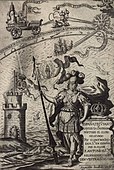
Allegory
As a literary device or artistic form, an allegory is a narrative or visual representation in which a character, place, or event can be interpreted to represent a meaning with moral or political significance. Authors have used allegory throughout history in all forms of art to illustrate or convey complex ideas and concepts in ways that are comprehensible or striking to its viewers, readers, or listeners.
For the concept in mathematics, see Allegory (mathematics).Writers and speakers typically use allegories to convey (semi-) hidden or complex meanings through symbolic figures, actions, imagery, or events, which together create the moral, spiritual, or political meaning the author wishes to convey.[2] Many allegories use personification of abstract concepts.
Types[edit]
Northrop Frye discussed what he termed a "continuum of allegory", a spectrum that ranges from what he termed the "naive allegory" of the likes of The Faerie Queene, to the more private allegories of modern paradox literature.[8] In this perspective, the characters in a "naive" allegory are not fully three-dimensional, for each aspect of their individual personalities and of the events that befall them embodies some moral quality or other abstraction; the author has selected the allegory first, and the details merely flesh it out.
Classical allegory[edit]
The origins of allegory can be traced at least back to Homer in his "quasi-allegorical" use of personifications of, e.g., Terror (Deimos) and Fear (Phobos) at Il. 115 f.[9] The title of "first allegorist", however, is usually awarded to whoever was the earliest to put forth allegorical interpretations of Homer. This approach leads to two possible answers: Theagenes of Rhegium (whom Porphyry calls the "first allegorist," Porph. Quaest. Hom. 1.240.14–241.12 Schrad.) or Pherecydes of Syros, both of whom are presumed to be active in the 6th century B.C.E., though Pherecydes is earlier and as he is often presumed to be the first writer of prose. The debate is complex, since it demands we observe the distinction between two often conflated uses of the Greek verb "allēgoreīn," which can mean both "to speak allegorically" and "to interpret allegorically."[10]
In the case of "interpreting allegorically," Theagenes appears to be our earliest example. Presumably in response to proto-philosophical moral critiques of Homer (e.g., Xenophanes fr. 11 Diels-Kranz[11]), Theagenes proposed symbolic interpretations whereby the Gods of the Iliad actually stood for physical elements. So, Hephestus represents Fire, for instance (for which see fr. A2 in Diels-Kranz[12]). Some scholars, however, argue that Pherecydes cosmogonic writings anticipated Theagenes allegorical work, illustrated especially by his early placement of Time (Chronos) in his genealogy of the gods, which is thought to be a reinterpretation of the titan Kronos, from more traditional genealogies.
In classical literature two of the best-known allegories are the Cave in Plato's The Republic (Book VII) and the story of the stomach and its members in the speech of Menenius Agrippa (Livy ii. 32).
Among the best-known examples of allegory, Plato's Allegory of the Cave, forms a part of his larger work The Republic. In this allegory, Plato describes a group of people who have lived chained in a cave all of their lives, facing a blank wall (514a–b). The people watch shadows projected on the wall by things passing in front of a fire behind them and begin to ascribe forms to these shadows, using language to identify their world (514c–515a). According to the allegory, the shadows are as close as the prisoners get to viewing reality, until one of them finds his way into the outside world where he sees the actual objects that produced the shadows. He tries to tell the people in the cave of his discovery, but they do not believe him and vehemently resist his efforts to free them so they can see for themselves (516e–518a). This allegory is, on a basic level, about a philosopher who upon finding greater knowledge outside the cave of human understanding, seeks to share it as is his duty, and the foolishness of those who would ignore him because they think themselves educated enough.[13]
In Late Antiquity Martianus Capella organized all the information a fifth-century upper-class male needed to know into an allegory of the wedding of Mercury and Philologia, with the seven liberal arts the young man needed to know as guests.[14] Also, the Neoplatonic philosophy developed a type of allegorical reading of Homer[15] and Plato.[16]
Biblical allegory[edit]
Other early allegories are found in the Hebrew Bible, such as the extended metaphor in Psalm 80 of the Vine and its impressive spread and growth, representing Israel's conquest and peopling of the Promised Land.[17] Also allegorical is Ezekiel 16 and 17, wherein the capture of that same vine by the mighty Eagle represents Israel's exile to Babylon.[18]
Allegorical interpretation of the Bible was a common early Christian practice and continues. For example, the recently re-discovered Fourth Commentary on the Gospels by Fortunatianus of Aquileia has a comment by its English translator: "The principal characteristic of Fortunatianus' exegesis is a figurative approach, relying on a set of concepts associated with key terms in order to create an allegorical decoding of the text."[19]
Modern allegory[edit]
Since meaningful stories are nearly always applicable to larger issues, allegories may be read into many stories which the author may not have recognized. This is allegoresis, or the act of reading a story as an allegory. Examples of allegory in popular culture that may or may not have been intended include the works of Bertolt Brecht, and even some works of science fiction and fantasy, such as The Chronicles of Narnia by C. S. Lewis.
The story of the apple falling onto Isaac Newton's head is another famous allegory. It simplified the idea of gravity by depicting a simple way it was supposedly discovered. It also made the scientific revelation well known by condensing the theory into a short tale.[22]







